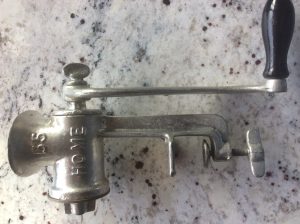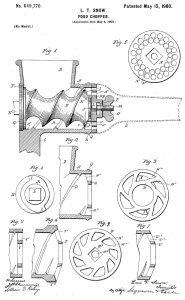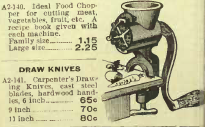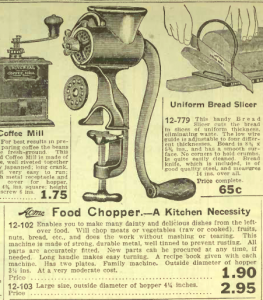Food Grinders
An image of a Home Food Grinder recently surfaced on the internet, with the caption, “Do you know what this is?”
I have kept my mother’s Home Food Grinder in my cupboard for years, mostly for sentimental reasons. My mother would hook it up to the kitchen table and my brother and sister and I were given the job of grinding up leftover roast beef. We were more than happy to do so because we knew then we’d have “hash” for dinner and we liked it better than roast beef.
[photo of 55 Home Food Grinder]
The image of the food grinder sent me on a research trail. First – the word “hash” dates back to the 1660s and comes from the French verb “hacher” meaning to “chop up” and the Old French “hache” for “ax or hatchet”.
Hash as a noun came to mean “a stew of meat cut into small pieces” and later in the mid 1700s to be “a mix or mess.”[i] It developed out of the need to turn leftovers, scraps and whatever one could find into a one-pot meal. In our house it was fried onions, the left over mashed potatoes (and any other vegetables), the ground up left over roast beef and the leftover gravy all mixed together in a large frying pan or skillet. Although you hardly need a recipe for hash, recipes did start to appear in cookbooks more so after the invention of the food grinder / chopper / mincer.
Karl Freiherr Drais of Karlsruhe, Germany (1785-1851) invented the food grinder, most likely in the 1830s. He’s better known for inventing an early form of the bicycle as well as the earliest typewriter, a wood-saving cooker and a railroad handcart.[ii] Supposedly, his early “land-running machine” or velocipede caused so much havoc it was banned until the 1880s.
Food grinders (also called choppers or mincers) have been in use in North America since the 1840s and became more popular after the Philadelphia Centennial Exposition in 1876 [iii]. The Canadian Encyclopedia describes them as” hollow iron cylinders containing rotary shafts with teeth that eventually evolved into a screw like revolving shaft that cut through the meat and forces it through a perforated end plate”[iv].
The design principle of Drais’ grinder is almost identical to food grinders used in kitchens and butcher shops around the world today. Levi T. Snow of Connecticut patented a food-chopper in Canada in 1897[v] and the US in 1900.
I set about trying to identify the company that might have produced the Home brand of my mother’s food grinder. New Haven, Connecticut along the U.S. Atlantic Seaboard was an early houseware manufacturing centre, and produced brands such as the Universal.[vi] Another common brand was Gem, or Sargent’s Gem made by the Sargent Manufacturing Company, of New Haven, Connecticut. In her Bibliography of Canadian Cookbooks (2008), Elizabeth Driver reports that several copies of at least two editions of the Gem Chopper Cookbook, also known as Sargent’s Gem Food Chopper Guide: Valuable recipes for substantial dishes and dainty desserts (1902) were available in Canada [vii].
So far I have located an Ideal brand chopper in the 1909-10 Eaton’s Catalogue[viii] which probably came from Ideal Mfg. Co. also in Něw Haven, Connecticut. I also found an Acme brand in the 1920-21 catalogue[ix] with a logo indicating it was made by the same company that made the Acme Motor Car.
I don’t know for sure what 55 means on my mother’s grinder. According to The Meat Grinder [x], the grinder number denotes the diameter of the grinder plate. A number 5 plate is fairly small and you would have to cut the meat into 1” cubes to fit through the feeding tube. I am inclined to think that the 55 in this case is the model number.
A food grinder used to be a common kitchen tool, ensuring that everyone could grind his or her own food, specifically meat. It changed the way we eat and it was critical to the evolution of the meatloaf,[xi] the ubiquitous hamburger,[xii] and of course, hash.
References
[i] https://www.etymonline.com/word/hash
[ii] Drais’ 1817 invention of the first known means of mechanized two-wheel transportation (a bicycle without pedals, powered by the feet) has been termed the Big Bang of horseless transportation. Read more about Drais’ two-wheeler and other inventions including the food grinder, typewriter, a wood-saving cooker, and a railroad handcart in: https://germanculture.com.ua/famous-germans/karl-drais-the-bicycle-and-typewriter-inventor/
[iii] Smith, A. (2008). Hamburger a Global History.London, UK: Reakton Books.
[iv] The Canadian Encyclopedia (2000). Domestic Utensils. Toronto ON: McClelland & Stewart.
[v] The Canadian Patent Office Record Volume XXV (1898). Ottawa, ON: Government Printing Bureau.
[vi] https://nbindustrial.org/collection/landers/
See the New Britain Industrial Museum (Connecticut) for further information such as: “The evolution of the belt sander. The evolution of the vacuum cleaner. The evolution of the meat grinder. The evolution of the coffee pot – one particular model had the following warning imprinted on the base:“Do not put in water.” The manufacturing company eventually changed the wording to, ‘Do not immerse in water.’”
[vii] Driver, E. (2008). Culinary Landmarks: A Bibliography of Canadian Cookbooks, 1825-1949. Toronto, ON: University of Toronto Press.
[viii] p. 172. https://archive.org/details/eatons190900eatouoft/page/n185
[ix] p. 537. https://www.torontopubliclibrary.ca/detail.jsp?Entt=RDMDC-EATONS19202100EATOUOFT&R=DC-EATONS19202100EATOUOFT
[x] https://meatgrinderhelp.com/what-do-the-numbers-on-meat-grinders-mean/
[xi] The meatloaf is an important part of food history. See:
Arumugam, N. (2011). From budget fare to culinary inspiration, the history of meatloaf. The Atlantic Magazine. https://www.theatlantic.com/health/archive/2011/09/from-budget-fare-to-culinary-inspiration-the-history-of-meatloaf/245265
Bruni, F. & Steinhauer, J. (2017). A meatloaf in every oven. New York, Boston: Grand Central Life & Style.
[xii] https://www.smithsonianmag.com/arts-culture/taste-testing-history-hamburger-180959789/





